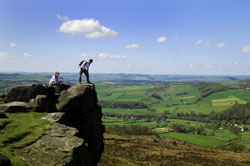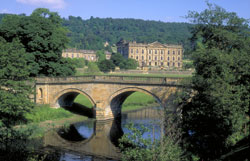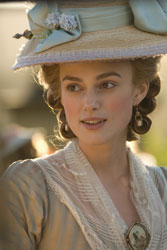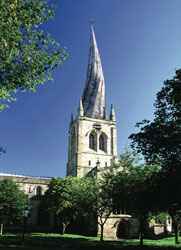With its breathtaking landscapes, world-class heritage, historic villages, market towns and famous film locations, it’s no wonder the Peak District in the heart of England continues to enchant visitors.
 |
| Lofty crags in the Peak District |
It may just be a short journey into the Peak District from the bustling cities of Manchester, Sheffield or Derby, but that swoop over dramatic hills and along idyllic valleys takes your breath away. The rolling hills, inhospitable peaks, fertile valleys and gorgeous villages of the Peaks are another world, and one with a charm all its own.
It’s easy to see why the Peak District became Britain’s first national park in 1951, just a couple of decades after the Kinder Trespass when lovers of the countryside mounted a mass trespass on Kinder Scout, and prompted legal changes which opened up access to Britain’s most beautiful areas. This stunning national park covers just 555 square miles, but the Peak District and surrounding towns and villages have a natural beauty and fascinating tradition that means visitors never want to leave.
And the Peaks have been well loved for thousands of years, as visitors to Arbor Low stone circle and Mam Tor hill fort quickly find. At Britain’s oldest human habitation at Creswell Crags, Ice Age cave dwellers from some 13,000 years ago left behind Britain’s earliest known cave art, etching graceful birds and animals into the stone.
At every turn in the Peak District, this graceful landscape tells tales of its fascinating past, from the dramatic moorland and gritstone of the Dark Peak in the north to the gentler limestone dales of the White Peak in the south.
Even the gentlest of climbs tells a story, as you walk up from the village of Castleton to sturdy Peveril Castle, where William the Conqueror’s trusted knight began the building work that continued through the 12th century.
Amid stunning scenery, you can trace the story of the Peaks within sheltering walls. So, at the gorgeous Haddon Hall near Bakewell, the weathered 12th-century walls shelter many a secret, as do the wonderfully atmospheric 14th-century banqueting hall with glorious musicians’ gallery. Owned by the same family since the time of Queen Elizabeth I, Haddon Hall shelters treasures like the fabulous Elizabethan Long Gallery with its magnificent plasterwork ceiling. In Tudor kitchens, you can almost feel the servants bustling between the massive ovens and the beautifully-preserved salting basins. And guests at the gracious 17th-century Biggin Hall – now a country house hotel – feel the pull of the past as they play croquet on rolling lawns where geese graze.
Yet there are heart-rending tales too. On that fateful day in 1665, when a tailor in the quaint village of Eyam opened a bale of cloth shipped from the grand city of London, he unleashed the deadly bubonic plague, which could have decimated an entire county and more. It took the courage of determined villagers, led by their resolute rector, to impose their own perilous quarantine and contain the deadly disease in their own village.
So, today, visitors wander from one pretty Plague Village cottage to the next, reading the heart-rending inscriptions with the tales of just how many in each home died, as they saved the county but paid their own terrible price. Across the fields, pools around the boundary stone once held vinegar to disinfect the coins the courageous villagers left in payment, as those from neighbouring villages left supplies for the residents of the plague-stricken village.
 |
| Chatsworth: The Palace of the Peaks |
The honeyed walls of Chatsworth, home to the 12th Duke and Duchess of Devonshire, tell entirely different tales. The long slow approach through the estate’s gracious grounds draws visitors all year round, from idyllic summer days when visitors stroll around the model village of Edensor to the darker nights when the stately home’s elegant rooms twinkle with Christmas lights, while choral music fills the scented air.
In the Music Room, eagle-eyed visitors are quick to spot that trompe l’oeil fiddle, painted on one wall as a superbly witty trick of the eye.
 |
| Keira Knightley as The Duchess |
If parts of the Peak District seem eerily familiar to visitors, it’s small wonder because these magnificent settings have been transformed in art and film so many times over the years. On the gracious lawns of Chatsworth, Keira Knightley filmed The Duchess and played the 18th-century Duchess of Devonshire in the real-life home of Georgiana, Duchess of Devonshire. And Haddon Hall became a magnificent backdrop to The Other Boleyn Girl and Cate Blanchett’s Elizabeth I in Elizabeth. Wonderful Peak locations became a perfect setting for filming Jane Eyre and Pride and Prejudice, and Mr Darcy’s spine-tingling wet shirt moment as he emerged from Jane Austen’s fictitious lake. These crags and wilderness settings have inspired great art down the centuries, from Charlotte Brontë’s Jane Eyre right through to the present day.
In such stunning scenery, it’s easy to see why the Peak District inspires so much enthusiasm for the great outdoors. With 1,600 miles of public rights of way, amid enough dry stone wall to reach right round the earth, thousands each year come to the Peak District to walk, climb, explore caves, ride mountain bikes, canter along old packhorse routes, go sailing and windsurfing, or get a birds-eye view on a hot air balloon ride.
So in the tiny village of Edale, walkers gather at dusk for a pint of good local ale at the atmospheric Old Nag’s Head pub after a hard day in the hills. As the starting point of the Pennine Way, the country’s first national trail which leads all the way to Scotland, Edale is a magnet for the hardy and well-equipped as well as for those starting gentler walks up The Nab to disappear into gorgeous hilltop landscapes. Farther south, in the idyllic Dovedale valley on the Staffordshire side of the Peak District, the walking around lovely villages such as Alstonefield is gentler but just as magnificent.
Yet this stunning landscape also conceals other glories of the Peak District, and which would be all too easy to miss. At Speedwell Cavern near Castleton, visitors don helmets to clamber down the 105 steps to the deepest cave in Britain open to the public. As the boat glides through the still dark waters, they muse on the perils faced by the 18th-century lead miners who risked death after they lit the straw detonators, and then waded for dear life to the nearest safety hole to shield them from the massive blast. Others swallowed toxins from tallow candles, gripped between their lips as they worked – average life expectancy for a lead miner was just 28. And while those hard-pressed miners threw thousands of tons of mining rubble into the still depths of the pool of the Bottomless Pit, the water’s level never rose.
Across the fields, Treak Cliff Cavern is home to the unique semi-precious Blue John stone. Fossils dot the roof of these ancient caverns, and stalactites and stalagmites droop and soar amid the sparkling Blue John crystals. Nearby, Peak Cavern boasts the biggest cavern entrance in Europe – and south of Buxton, Poole’s Cavern is a natural limestone cave home to more impressive stalactite clusters formed over many millennia.
This earth holds some splendid treasures, as the Romans discovered in what is now the elegant town of Buxton – hot springs gush from the ground here at a delightful temperature. And when Mary Queen of Scots stayed here, local legend has it that she used a private stairwell from her imprisoning chambers to take the waters deep below what is now the Old Hall Hotel.
Those delightful waters also inspired the 5th Duke of Devonshire to build his own spa, with Buxton’s elegant Crescent inspired by the one in Bath. And long-standing tradition means that visitors to the town still wait to fill their drinking bottles with the clear water of St Ann’s Well, near the wonderful Edwardian Opera House.
Unique customs are everywhere in the Peaks, and summer visitors look out for a tradition that could go back to the Celts or even earlier. In every tiny village, the art of well dressing means creating the most glorious pictures around wells and springs with flower petals, feathers, seeds and berries, following a fine tradition that has survived despite Church opposition.
Other local traditions are more recent – the cook in Bakewell who got the recipe wrong and spread the egg on the strawberry tart instead of mixing it into the pastry, and inadvertently created the famous Bakewell Pudding locals still devour today (similar Bakewell tarts also originated here).
 |
| Chesterfield’s twisted spire |
Or the huge open-air market at Chesterfield, close to that famous twisting spire which is a local landmark, and a great place to browse before hunting down the local museum. In this part of the world, Sir Richard Arkwright built the world’s first successful water-powered spinning mill near Cromford, where visitors today tour the village lock-up and pigsties. Pretty villages like Tissington and Hartington and lovely Georgian towns of Ashbourne and Melbourne, all surrounded by the most glorious Peaks scenery, are just more great reasons to explore the Peak District. And come back, time after time, as so many do.
For details of what to see and do and where to stay in the Peak District area, www.visitpeakdistrict.com. Tourist Information Centres: 13 Market Place, Ashbourne DE6 1EU; tel: (01335) 343666; The Old Market Hall, Bridge Street, Bakewell DE45 1DS; tel: (01629) 816558; Pavilion Gardens, St John’s Road, Buxton SK17 6XN; tel: (01298) 25106.
Take a peak at this:
- Biggin Hall Country House Hotel (2-star), Buxton. Historic house dating back to the 17th century, in the heart of the Peak District. Tel: (01298) 84451; www.bigginhall.co.uk. BRITAIN XTRA: Read more about this great hotel in our full review…
- Buxton Opera House, Buxton. Lovingly restored to its former glory in 2001 and home to the prestigious Buxton Festival and live music festivals too. Tel: (0845) 127 2190; www.buxton operahouse.org.uk.
- Chatsworth, Bakewell. One of Britain’s most famous stately homes complete with deer park, arboretum, rose garden, farmyard and award-winning farm shop. Tel: (01246) 565300; www.chatsworth.org.
- Creswell Crags, Worksop, Nottinghamshire. Limestone gorge honeycombed with caves and famous as the most northern home of our Ice Age ancestors. See stone tools and fascinating art. Tel: (01909) 720378; www.creswell-crags.org.uk.
- Eyam: The Plague Village, a moving testament to the courage of the people when the Plague struck in 1665. Eyam Museum. Tel: (01433) 631371; www.eyammuseum.demon.co.uk.
- Haddon Hall, Bakewell. Tremendous old-world atmosphere in this hidden gem steeped in medieval and Tudor history, and with wonderful features from the 12th and later centuries. Tel: (01629) 812855; www.haddonhall.co.uk.
- Ilam Hall and Dovedale: Gardens owned by the National Trust and close to a beautiful valley, with a great tea room. Tel: (01335) 350503; www.nationaltrust.org.uk.
- Red House Working Carriage Museum, Matlock. Great working carriages, often seen on local lanes – take a carriage ride or learn to drive yourself. Tel: (01629) 733583; www.workingcarriages.com.
- Speedwell Cavern, Castleton, Hope Valley. At the foot of the glorious Winnat’s Pass, close to the village of Castleton descend the 105 steps to this deepest of caves. A boat trip through this 200-year-old lead mine is unmissable. Tel: (01433) 620512; www.speedwellcavern.co.uk






 © 2024
© 2024